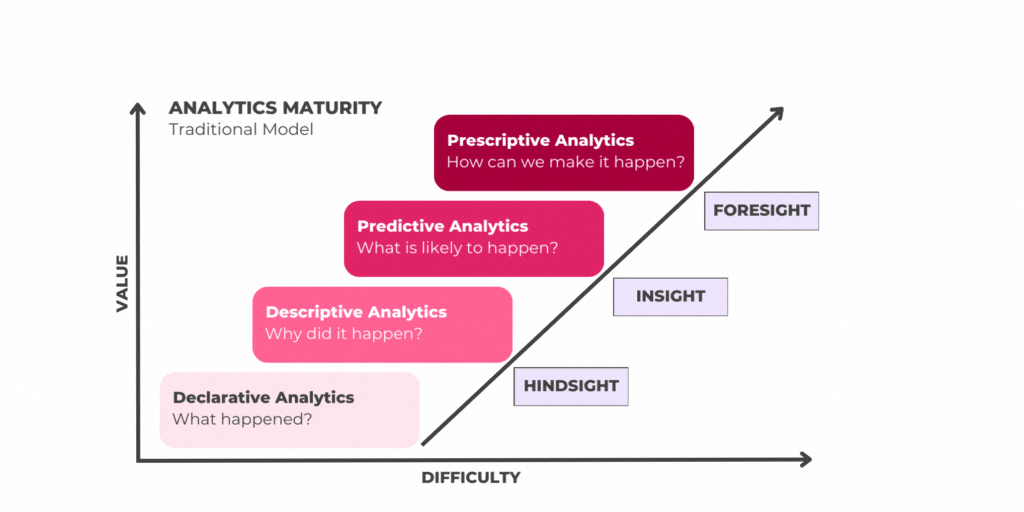
By Kevin Mattice, Chief Product Officer
AI has become a buzzword that’s hard to ignore. Boards, bosses, colleagues, and data science teams are seem to echo the same sentiment: “We need an AI strategy, and we need it now!”
Amidst all the hype, it can be challenging to distinguish genuine value from noise, avoid the bullsh!t, and develop a strategy that truly benefits your organization. In this article, we’ll dive into the essential components of creating an effective AI strategy.
The pressure is palpable, as every organization rushes to launch chatbots and other AI-driven tools with lofty promises about performance. The proliferation and visibility might leave you with a myriad of questions:
The answer to that last one is an unequivocal YES. Yes, you should care — for the same reasons that you care about having a BS-free data strategy. It’s because you want to:
Before we explore how to un-BS your AI strategy, we need to untangle the web of AI terminology.
“AI” is a big and broad field. Saying you’re going to use “AI” to solve something is like saying that “the internet” can solve something. To complicate matters further, when most people refer to AI these days, they usually mean Generative AI.
Here’s what these terms actually mean:
AI
The theory and development of computer systems able to perform tasks that normally require human intelligence. This is the big umbrella under which the other terms fall. Very simply, it’s about teaching computers and technology how to think and make decisions like humans do.
Machine Learning
A subset of AI that focuses on teaching machines how to perform a specific task and provide accurate results by identifying patterns. Machine learning is really about patterns. This form of AI has been around longer than generative AI, but it’s often overlooked or conflated with looking at patterns, recognizing things within data, to teach those machines how to make decisions.
Generative AI
Artificial intelligence capable of generating text, images, or other media. “Generative AI” is the buzzword of the year, and it’s a narrower concept than the others. This is AI as it relates to text and large language models.
Large Language Models (LLMs)
Powerful AI systems, like ChatGPT, with billions of parameters, trained to understand, generate, and manipulate human-like language for tasks such as text completion and translation. They excel in language-related applications.
GPT (Generative Pre-Trained Transformers)
A specific class of generative AI models developed by OpenAI, pre-trained on vast amounts of data to generate human-like text.

You’ve likely seen this graphic before: the data maturity and analytics continuum. Most organizations start their data journey on the bottom-left with declarative and descriptive analytics – looking at what’s happened in the past.
To remain competitive, especially during a challenging market, you need to move from hindsight to foresight. But it’s a long journey to get there. These days, rushing to AI is often seen as a quick fix — but this is like wielding a hammer in search of nails.
It’s crucial to focus on the problems you need to solve along your journey to foresight, not just the tools you plan to use.
AI is like having a powerful hammer, but not every problem is a nail. So, let’s address the central issue: finding the right problems for your AI solutions.
Imagine this scenario: You’re under pressure from your boss and board to embrace AI, so you decide to build an AI chatbot using generative AI. You proudly present it to your asset management team, promising that it can answer any question they have.
The asset management team asks the chatbot a seemingly straightforward question: “How should we price our new multifamily units in Dallas?”
Teeming with confidence, you type the question into the chatbot and press the “return” key with a flourish. After processing for a moment, the chatbot confidently responds with “$500/sqft.”
…huh? What went wrong?
As technologists, we’ve all been there: Rarely is anything as simple as it seems. If you investigate the data feeding your chatbot, for example, we might discover:
To prevent such mishaps, you need to ensure that your AI tool is the right one for the job. If you’re trying to figure out pricing in Dallas, perhaps a chatbot leveraging generative AI isn’t the right solution. Or maybe it is, and you need to ensure your underlying data is correct and complete first.
Remember: It’s not just about finding nails for your AI hammer — it’s about knowing how and where to use the hammer.
To know when to use the hammer, you need to step back from technology and do some organizational planning first. At Cherre, we specialize in productizing AI and data for real estate, so we have some suggestions from our years of experience.
Imagine your ideal outcome. Write a press release describing it, and let that vision guide your strategy. Your press release should declare what your AI solution will achieve, highlighting the benefits it will bring to your organization and the market.
Let’s think back to that chatbot example. Instead of writing your press release stating, “We built an AI chatbot,” frame it as “We launched an AI chatbot that is so accurate that we can instantly and accurately price anything we want, leaving our competitors scrambling.”

Now that you’ve defined your strategy and goal, align your teams and give them direction with a goal-setting framework.
We recommend utilizing OKRs to establish clear objectives and key results that align overall company and team goals. OKRs connect your data science, engineering, and business teams, ensuring everyone is working toward a common purpose.

You’ve crafted your press release and identified what needs to be true at the end of your journey. You’ve defined the roadmap for building that groundbreaking product or executing your market strategy. Now it’s time to think about how you turn these ideas into reality and the people who make it happen. At Cherre, this is where we use a “Jobs to Be Done” framework.
The “Jobs to be Done” framework brings together your data science teams, engineers, and business experts to identify the individuals who are at the heart of your AI solution’s success. Gather these stakeholders in a room and ask the crucial questions:
By defining these user personas and understanding their daily routines, you lay the foundation for creating AI solutions that seamlessly fit into their workflows and address their pain points, ensuring that it becomes an indispensable part of your success story. This approach not only empowers your team but also sets you on the path to achieving your objectives with AI in a way that truly resonates with your end users.

Now that you have a clear understanding of your end users’ needs, it’s time for design thinking. Gather your data and technical experts with your business experts to frame the challenges of your end users, and pinpoint areas where AI can provide solutions to their daily workflows.
At this stage, it’s important to not try to boil the ocean. Start to iterate, and have your teams build and test small releases of AI in critical areas for your end users.
Remember, while Generative AI is a valuable tool, it’s not a universal solution. It’s essential to use the right tool for the right job.
Let’s go back to our original example of the magic AI chatbot failing miraculously about Dallas pricing, and break down some of those issues. AI can help with some of these challenges, but not all:
As you can see, GenAI isn’t going to solve all your problems – but it can help you solve them by sitting on top of your data to get where you need to be.
Even with AI, you won’t reach predictive and prescriptive analytics without a robust data foundation. Fix data gaps, understand past data, and ensure its quality before attempting to predict the future. AI should complement your strategy, not replace it.

In the rush to implement AI strategies, it’s easy to get lost in the noise. But a successful AI strategy requires more than launching products or throwing technology at problems. It begins with a clear vision, well-defined objectives, and a deep understanding of your end users’ needs. By employing the right tools and building on a strong data foundation, you can unbullsh!t your AI strategy and lead your organization towards a brighter, data-driven future.